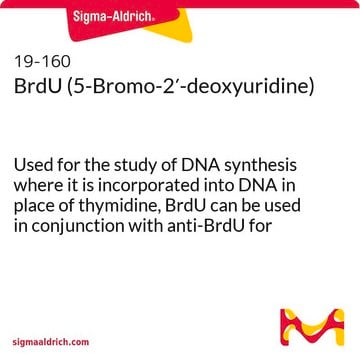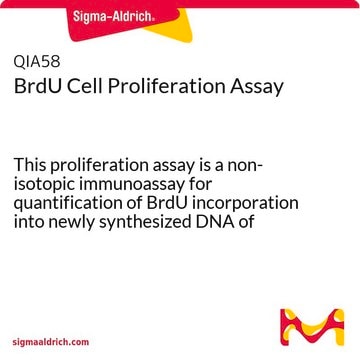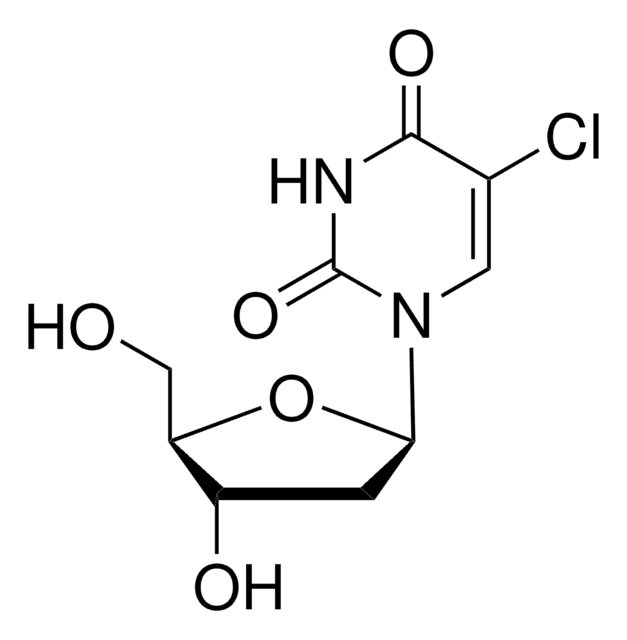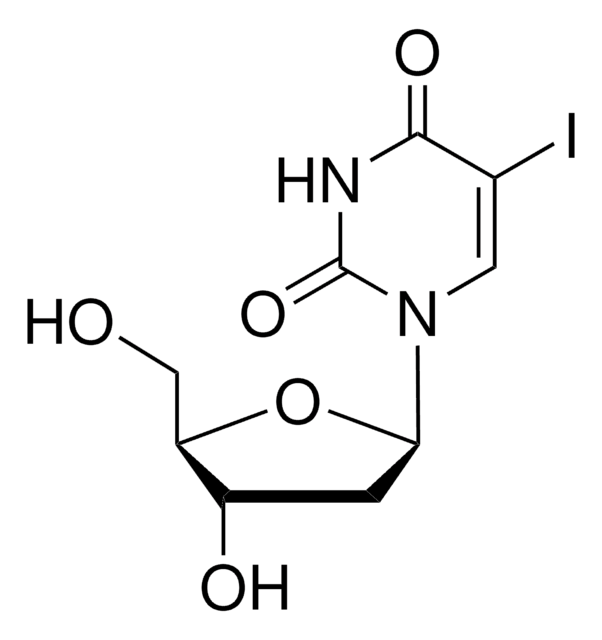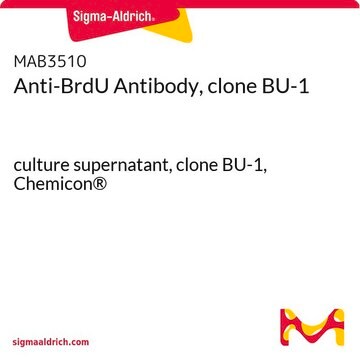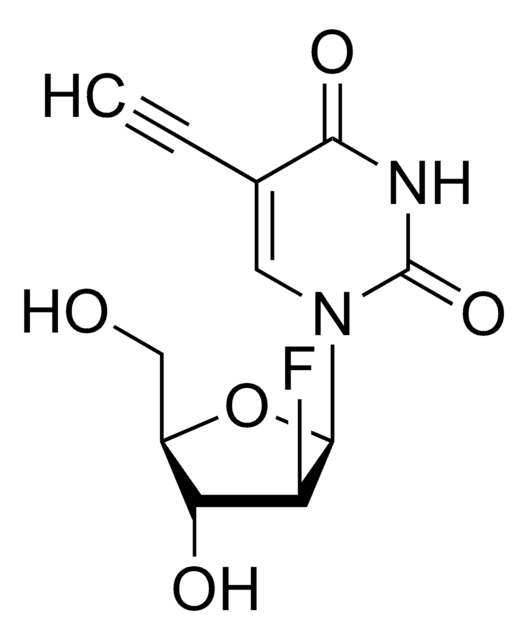5-Bromo-2´-deoxyuridine is stable in solution for 6 months when stored -20°C.
推荐产品
生物源
synthetic (organic)
品質等級
產品線
BioUltra
化驗
≥99%
形狀
powder
雜質
≤0.005% Phosphorus (P)
≤0.1% Insoluble matter
燃燒殘留物
≤0.1%
mp
191-194 °C (dec.) (lit.)
溶解度
NH4OH: 0.1 M at 20 °C, clear, colorless
正離子痕跡
Al: ≤0.0005%
Ca: ≤0.01%
Cu: ≤0.0005%
Fe: ≤0.0005%
K: ≤0.005%
Mg: ≤0.0005%
NH4+: ≤0.05%
Na: ≤0.05%
Pb: ≤0.001%
Zn: ≤0.0005%
儲存溫度
−20°C
SMILES 字串
OC[C@H]1O[C@H](C[C@@H]1O)N2C=C(Br)C(=O)NC2=O
InChI
1S/C9H11BrN2O5/c10-4-2-12(9(16)11-8(4)15)7-1-5(14)6(3-13)17-7/h2,5-7,13-14H,1,3H2,(H,11,15,16)/t5-,6+,7+/m0/s1
InChI 密鑰
WOVKYSAHUYNSMH-RRKCRQDMSA-N
正在寻找类似产品? 访问 产品对比指南
相关类别
訊號詞
Danger
危險聲明
危險分類
Muta. 1B - Repr. 2
儲存類別代碼
6.1C - Combustible acute toxic Cat.3 / toxic compounds or compounds which causing chronic effects
水污染物質分類(WGK)
WGK 2
個人防護裝備
Eyeshields, Gloves, type N95 (US)
其他客户在看
-
For how long is Product B9285, 5-Bromo-2´-deoxyuridine, stable in solution?
1 answer-
Helpful?
-
-
What is the Department of Transportation shipping information for this product?
1 answer-
Transportation information can be found in Section 14 of the product's (M)SDS.To access the shipping information for this material, use the link on the product detail page for the product.
Helpful?
-
-
In what solvents is Product B9285, 5-Bromo-2´-deoxyuridine, soluble?
1 answer-
Solubility information for 5-bromo-2´-deoxyuridine can be found on the product information sheet (under Documents, above).
Helpful?
-
-
What is the shelf life of Product No. B9285 (5-bromo-2´-deoxyuridine)?
1 answer-
Sigma-Aldrich does not assign an expiration date to this product; it is guaranteed for one year from the date of shipment.
Helpful?
-
-
Can Product B9285, 5-Bromo-2´-deoxyuridine, be injected into animals?
1 answer-
Sigma has not injected animals with solutions of this compound, so we do not have a stepwise procedure for you. However, this application has been reported in the literature. Please see the cited references below, which you may find useful. Several references cite the use of Product No. B9285 in their protocols.1. Yin, X-X, et al., Expression of active caspase-3 in mitotic and postmitotic cells of the rat forebrain. J. Comp. Neurol., 433(1), 4-22 (2001). Injected into mice at 50 mg/kg.2. Dackor, R.T., et al., Hydrops Fetalis, Cardiovascular Defects, and Embryonic Lethality in Mice Lacking the Calcitonin Receptor-Like Receptor Gene. Mol. Cell. Biol., 26(7), 2511-2518 (2006). Injected into mice at 100 mg/kg.3. Farris, S.M., et al., Larval and Pupal Development of the Mushroom Bodies in the Honey Bee, Apis mellifera. J. Comp. Neurol., 414, 97-113 (1999). A 25 mg/mL solution was injected into bee larvae, prepupae, and pupae.4. Gaiano, N., et al., Radial Glial Identity Is Promoted by Notch1 Signaling in the Murine Forebrain. Neuron, 26(2), 395-404 (2000). A 20 mg/mL solution was injected into mice.
Helpful?
-
Active Filters
我们的科学家团队拥有各种研究领域经验,包括生命科学、材料科学、化学合成、色谱、分析及许多其他领域.
联系技术服务部门
